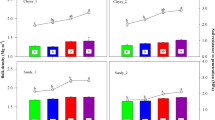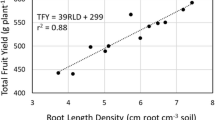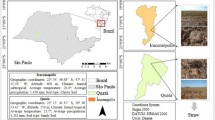Abstract
Strawberry is a high value crop worth 315.6 million euros in 2013 in Spain. Strawberry diseases are commonly controlled by soil fumigation with toxic chemicals. However, since 2007, the methyl bromide fumigant is banned for strawberry cultivation. Moreover, European policies are progressively restricting the use of other toxic fumigants such as dichloropropene. Alternative control techniques are thus needed. Therefore, we have tested soil biosolarization, a new technique combining soil biofumigation and soil solarization, to cultivate the Camarosa strawberry in 2010–12 at Huelva in the southwestern coast of Spain. Soil was biofumigated by amendment of fresh chicken manure at 12,500 kg/ha with or without Trichoderma at 3.5 kg/ha; chicken manure at 25,000 kg/ha; Brassica juncea pellets at 2,000 kg/ha; sugar beet vinasse at 15,000 kg/ha; or dried olive pomace at 12,500 kg/ha. Soil was then solarized for 30 days by covering with a clear plastic mulch. A control that received fermented manure remained uncovered. Our results show that the highest yield averaging 70,543 kg/ha and the lowest percentage of 12.6 % of second-class fruits were obtained by amendment of fresh chicken manure. Yields were also similar to the higher yields previously reported for chemical fumigation with 1,3-dichloropropene and chloropicrin. In addition, biosolarization is about 20 % cheaper than treatment with 1,3-dichloropropene and chloropicrin. Biosolarization with chicken manure is, therefore, a promising sustainable option for strawberry production.





Similar content being viewed by others
References
Ajwa H, Othman M (2013) Allyl isothiocyanate and dimethyl disulfide for strawberry production. 2013 Proceedings of Annual International Research Conference on Methyl Bromide Alternatives and Emissions Reductions. San Diego (CA), pp 3–1
Angus JF, Gardner PA, Kirkegaard JA, Desmarchelier JM (1994) Biofumigation: isothiocyanates released from Brassica roots inhibit growth of the take-all fungus. Plant and Soil 162:107–112. doi:10.1007/BF01416095
Bello A, López-Pérez JA, Díaz L, Sanz R, Arias M (1999) Bio-fumigation and local resources as methyl bromide alternatives. Abstracts 3rd International Workshop Alternatives to Methyl Bromide for the Southern European Countries. Crete (Greece), pp 17
Daugovish O, Koike S, Gordon T, Ajwa H, Bolda M, Legard D (2009) Fumigant and strawberry variety evaluations in Macrophomina and Fusarium fields. 2009 Proceedings of Annual International Research Conference on Methyl Bromide Alternatives and Emissions Reductions. San Diego (CA), pp 13-1/13-4
Daugovish, O, Shennan C, Muramoto J, Koike S (2011) Anaerobic soil disinfestation for southern California strawberry. 2011, Proceedings of Annual International Research Conference on Methyl Bromide Alternatives and Emissions Reductions. San Diego (CA), pp 2-1/2-4
Daugovish O, Fennimore S, Koike S, Gordon T, Muramoto J, Shennan C, Subbarao K (2013) Non-fumigant treatments for management of Fusarium oxysporum and Macrophomina on strawberry cultivar San Andreas.. 2013 Proceedings of Annual International Research Conference on Methyl Bromide Alternatives and Emissions Reductions. San Diego (CA), pp 18–1 to 18–4
Duniway JM (2002) Status of chemical alternatives to methyl bromide for pre-plant fumigation of soil. Phytopathol 92:1337–1343. doi:10.1094/PHYTO.2002.92.12.1337
Eghball B, Power F, Gilley E, Doran W (1997) Nutrient, carbon, and mass loss of beef cattle feedlot manure during composting. J Environ Qual 26:189–193. doi:10.2134/jeq1997.00472425002600010027x
FAOSTAT agricultural data (2011)
Fennimore S, Serohijos R, Samtani J, Ajwa H, Subbarao K, Martin F, Daugovish O, Legard D, Browne G, Muramoto J, Shennan C, Klonsky K (2013) TIF film, substrates and non-fumigant disinfestation maintain yields. California Agric 67:139–146. doi:10.3733/ca.v067n03p139
Fenoll J, Ruiz E, Hellin P, Navarro S, Flores P (2010) Solarization and biosolarization enhance fungicide dissipation in the soil. Chemosphere 79:216–220. doi:10.1016/j.chemosphere.2010.01.034
Gliotti C, Gisquiani PL, Businelli D, Machione A (1997) Compositional changes of dissolved organic matter in a soil amended with municipal waste compost. Soil Sci 162:919–926
Hoitink HA (1986) Basis for the control of soil-borne plant pathogens with compost. Annu Rev Plant Physiol Plant Mol Biol 24:93–114. doi:10.1146/annurev.py.24.090186.000521
Katan J (1981) Solar heating (solarization) of soil for control of soil-borne pests. Annu Rev Plant Physiol Plant Mol Biol 19:211–236. doi:10.1146/annurev.py.19.090181.001235
Kierkegaard JA, Sarwad M (1998) Biofumigation potential of brassicas I. Variation in glucosinolate profile of diverse field-grown brassicas. Plant and Soil 201:71–89. doi:10.1023/A: 1004364713152
Koike STT, Gordon R, Daugovish O, Ajwa H, Bolda M, Subarao K (2012) Recent developments on strawberry plant collapse problems in California caused by Fusarium and Macrophomina. Int J Fruit Sci 13:76–83. doi:10.1080/15538362.2012.697000
Litterick AM, Harrier L, Wallace P, Watson CA, Wood M (2004) The role of uncomposted materials, composts manures, and compost extracts in reducing pest and disease incidence and severity in sustainable temperate agricultural and horticultural crop production—a review. Crit Rev Plant Sci 23:453–479. doi:10.1080/07352680490886815
López-Aranda JM (2008) The cultivation of the strawberry in Huelva. In: de Andalucía J (ed) The strawberry crop at Huelva. Ideas, Exclusivas y Publicidad S.L., Sevilla (Spain), pp 101–174
López-Aranda JM (2013) Agricultural production in the EU five years after the end of methyl bromide: problems and solutions. 2013 Proceedings of Annual International Research Conference on Methyl Bromide Alternatives and Emissions Reductions. San Diego (CA), Plenary session
López-Martínez N, Castillo S, Aguirre I, González-Zamora JE, Ávila C, López-Medina J (2006) Effect of biofumigation on typical weeds of strawberry fields. Acta Hort 708:193–196
Martínez MA, Martínez MC, Bielza P, Tello J, Lacasa A (2011) Effect of biofumigation with manure amendments and repeated biosolarization on Fusarium densities in pepper crops. J Ind Microbiol Biotechnol 38:3–11. doi:10.1007/s10295-010-0826-2
Mazzola M (2011) Potential of biofumigation of soilborne pest control in strawberry. 2011 Proceedings of Annual International Research Conference on Methyl Bromide Alternatives and Emissions Reductions. San Diego (CA), pp 47-1/47-2
Medina-Mínguez JJ, Miranda L, Domínguez P, Soria C, Pérez-Jiménez RM, Zea T, Talavera M, Velasco L, Romero F, Delos Santos B, López-Aranda JM (2012) Comparison of different chemical and non-chemical alternatives to methyl bromide for strawberry in Huelva (Spain). J Berry Res 2:113–121. doi:10.3233/JBR-2012-032
Núñez-Zofio M, Larregla S, Garbisu C (2011) Application of organic amendments followed by soil plastic mulching reduces the incidence of Phytophthora capsici in pepper crops under temperate climate. Crop Prot 30:1563–1572. doi:10.1016/j.cropro.2011.08.020
Rosskopf E. Kokalis-Burelle N, Butler D, Muramoto J, Shennan C, NolingJ, He ZH, Pierce F, Lake A, Booker B, Sances F, Campbell T (2011) Field evaluations of non-fumigant pest control for Florida strawberry production. 2011 Proceedings of Annual International Research Conference on Methyl Bromide Alternatives and Emissions Reductions. San Diego (CA), pp 45-1/45-4
Shennan C, Muramoto J, Baird G, Koike S, Bolda M, Mazzola M (2013) Optimizing anaerobic soil disinfestation for soilborne disease control. 2013 Proceedings of Annual International Research Conference on Methyl Bromide Alternatives and Emissions Reductions. San Diego (CA), pp 13-1/13-4
Teruhiko S, Masahiro N, Keiichi H (2001) Control of Fusarium wilt of strawberry by soil solarization using mulching and tunnel-covering combining with irrigation of solar-heated water. Bull of the Nara Perfectural Agric Exp Station 32:1–7
Tran TT (1998) Antagonistic effectiveness of Trichoderma against plant fungal pathogens. Plant Prot 4:35–38
Zurera C, Romero E, Porras M, Barrau C, Romero F (2007) Efecto biofumigante de especies de Brassica en el crecimiento de Phytophthora spp. in vitro. Actas de Horticultura 48:306–309
Zveibil A, Freeman S (2005) First report of crown and root rot in strawberry caused by Macrophomina phaseolina in Israel. Plant Dis 8:1014. doi:10.1094/PD-89-1014C
Acknowledgments
This work was financially supported by the INIA Agreement CC09-074-C5, Transforma Project PP.TRA.TRA201300.6, and FEDER funds.
Author information
Authors and Affiliations
Corresponding author
Additional information
All authors contributed equally to this work.
About this article
Cite this article
Domínguez, P., Miranda, L., Soria, C. et al. Soil biosolarization for sustainable strawberry production. Agron. Sustain. Dev. 34, 821–829 (2014). https://doi.org/10.1007/s13593-014-0211-z
Accepted:
Published:
Issue Date:
DOI: https://doi.org/10.1007/s13593-014-0211-z




